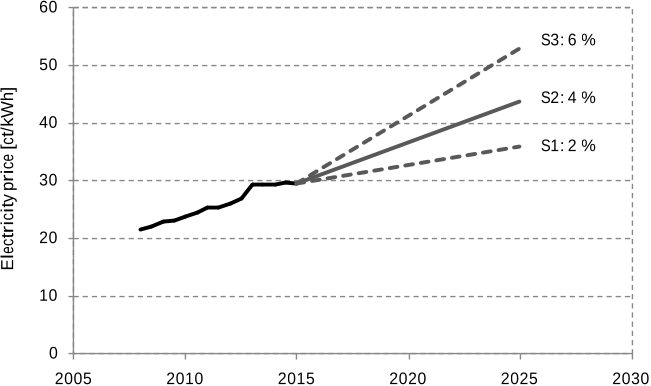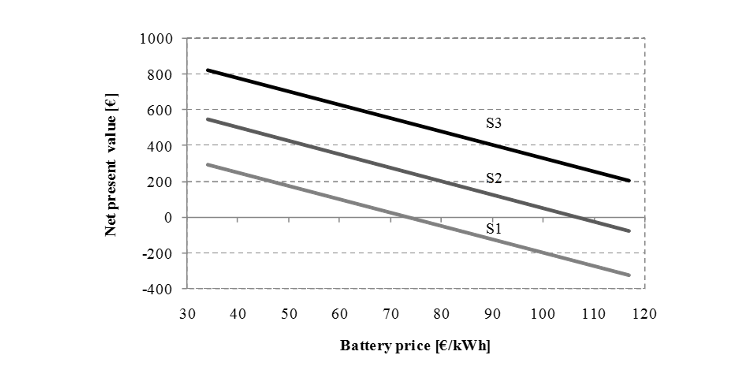
FCN Working Paper No. 7/2016
Economic Viability of Second-Life Electric Vehicle
Batteries for Energy Storage in Private Households
Alexander Kirmas and Reinhard Madlener
July 2016
Revised April 2017
Institute for Future Energy Consumer
Needs and Behavior (FCN)
School of Business and Economics / E.ON ERC

FCN Working Paper No. 7/2016
Economic Viability of Second-Life Electric Vehicle Batteries for Energy Storage in
Private Households
July 2016
Revised April 2017
Authors´ addresses:
Alexander Kirmas
RWTH Aachen University
Templergraben 55
52056 Aachen, Germany
E-Mail: alexander.kirmas@rwth-aachen.de
Reinhard Madlener
Institute for Future Energy Consumer Needs and Behavior (FCN)
School of Business and Economics / E.ON Energy Research Center
RWTH Aachen University
Mathieustrasse 10
52074 Aachen, Germany
E-Mail: RMadlener@eonerc.rwth-aachen.de
Publisher: Prof. Dr. Reinhard Madlener
Chair of Energy Economics and Management
Director, Institute for Future Energy Consumer Needs and Behavior (FCN)
E.ON Energy Research Center (E.ON ERC)
RWTH Aachen University
Mathieustrasse 10, 52074 Aachen, Germany
Phone: +49 (0) 241-80 49820
Fax: +49 (0) 241-80 49829
Web: www.eonerc.rwth-aachen.de/fcn
E-mail: post_fcn@eonerc.rwth-aachen.de

1
Economic viability of second-life electric vehicle batteries
for energy storage in private households
Alexander Kirmas
a
and Reinhard Madlener
b,*
a
RWTH Aachen University, Templergraben 55, 52056 Aachen, Germany
b
Institute for Future Energy Consumer Needs and Behavior (FCN), School of Business and Economics / E.ON
Energy Research Center, RWTH Aachen University, Mathieustrasse 10, 52074 Aachen, Germany
July 2016, revised April 2017
Abstract
We examine the economic viability of second-life batteries from electric vehicles for load shifting and
peak shaving in residential applications. We further investigate the expected impact of a growing
number of residential storage systems on the electricity market. For the analysis a simulation model of
a private household with integrated PV-storage system is used that is parametrized for an electricity
demand of three people and a location in southern Germany. The conditions for which investments in
second use batteries are profitable are examined for three scenarios. The central scenario S2 tackles an
expected net increase in the electricity price by 4% per year. Upward and downward deviations from
this price trajectory are covered by scenarios S1 and S3. For scenario S1, we find that investments in
storage systems are profitable for all Li-ion battery costs assumed. In scenario S2, the breakeven battery
price is found to be 107 € kWh
-1
, whereas in scenario S3 with the lowest electricity price growth the
battery price has to be equal or lower than 73 € kWh
-1
to maintain economic viability.
Keywords: E-vehicle, Residential electricity, Battery storage, Load shifting, Peak shaving
1. Introduction
Renewable energy technologies are a promising way to mitigate the consequences of climate
change and the finiteness of fossil fuels. However, the intermittent electricity output from
technologies like solar photovoltaic systems is volatile and depends on daytimes or local
weather conditions. Energy storage technologies can help to match supply and demand. Reused
batteries from (hybrid) electric vehicles may provide a storage technology with environmental
*
Corresponding author. Tel.: +49-241-80-49-820; fax: +49-241-80-49-829; E-mail address:
RMadlener@eonerc.rwth-aachen.de (R. Madlener)

2
and economic benefits to utilities, companies and homeowners. In the upcoming years the
global society is confronted with a variety of challenges. Climate change and fossil fuel
resource depletion are some challenges the energy economy has to find solutions for.
Renewable energy technologies will play a significant role in mitigating the consequences of
these challenges [1]. Governments of many countries have passed laws to support the transition
to sustainable energy generation. In Germany policy makers decided to foster the development
of renewable energy technologies through the provision of guaranteed feed-in tariffs. This
funding made rooftop photovoltaic (PV) systems attractive to private homeowners. However,
the energy generation from PV systems strongly depends on time of day and local weather
conditions and brings an element of uncertainty to the power grid [2]. Furthermore, the peak in
energy generation around noon produces a mismatch in demand and supply and is a threat to
the stability of the electricity system [3].
A feasible way to compensate for this mismatch is to adjust the energy supply by using
conventional power plants (like modern gas-fired power plants) which can be modulated
relatively quickly. But with limited capacities and an increasing amount of energy fed in by
renewables, other options have to be considered. The mismatch exists because the power supply
generated by PV systems is highest during the day with a peak around noon, whereas power
demand is low during the day and increases in the evening hours. The use of storage
technologies and smart grid technologies represents a promising way to shift energy demand
from the evening hours to the hours with a surplus of renewable energy generation.
In battery storage systems the electricity is stored through an electro-chemical process. Due
to decreasing battery costs they have become a potentially important alternative to other storage
technologies and several pilot projects have been started in recent years. Although battery costs
have declined, [4]-[6] could not find evidence that investments in battery storage were
profitable under present conditions. The costs per kWh decrease further if used battery storage
units are taken into consideration. In this case, the benefits from lower costs have to be balanced
with the downsides (e.g., lower capacity and efficiency, earlier replacement need of used battery
systems).
In the automotive industry the “second life” of retired batteries from electric vehicles is a
much debated issue, and nearly all of the major car manufacturers are currently determining
possible applications for their batteries after they have reached a capacity between 70-80%
through aging during their “first life” in the vehicle. Most industry experts expect them to be
used as stationary storage for renewable energy production, since they still retain significant
capacity. In recent years, several projects were implemented in order to gather knowledge about

3
the feasibility and the capabilities of the second life usage. For instance, Nissan and Green
Charge Networks, a large provider of commercial energy storage, have embarked on a
partnership for the commercial use of the retired batteries from the Nissan Leaf, which is one
of the world’s top-selling electric vehicle [7]. Toyota started a partnership with the Yellowstone
National Park and provides a ranger station and education center with power from a hybrid PV-
battery system [8]. General Motors has tested their batteries from the Chevrolet Volt to provide
solar and wind power to their new IT center in Milford, Michigan. However, the projects of
Toyota and General Motors are mostly isolated applications, whereas in Germany grid-
connected solutions by Daimler and BMW are explored. A cooperation between Daimler, The
Mobility House, GETEC and REMONDIS provides a 13 MWh energy storage unit to balance
the energy in the electricity grid [9] and BMW, Bosch and Vattenfall operate a battery pack as
part of a virtual power plant in Hamburg [10]. The discussion shows the relevance of using
batteries as energy storage systems, and the importance of taking a closer look at the
requirements for a successful implementation, the consequences, and the resulting implications.
The question arises concerning the conditions under which the economic viability of the
residential PV-storage system is given. The purchase and maintenance not only of the battery
but of the other system components, like the inverter, has to provide a benefit to the decision
maker, in this case the homeowner. Possible benefits for other involved parties, like the grid
operators, may be shared with the decision maker in order to positively influence economic
viability. In addition to that, policy makers may foster the spread of the storage technology
through various incentives like credits at reduced interest rates. Further, it is important to
estimate what impact a growing number of residential battery storage systems has on the
market, the electricity sector, and policy-making. Finally, there is the question concerning
which implications and guidance can be derived from the results for energy companies, grid
operators, car manufactures, and policy makers.
The research objective is to determine the economic viability of the implementation of a
used battery from an electric (EV) or hybrid electric vehicle (HEV) in a residential application
for load-shifting and peak-shaving. Precisely, a household with a PV generation system is
considered and the benefit of combining it with a battery storage system is examined. The
battery technology is limited to lithium-ion as it is the dominant technology for EVs and HEVs
today.
The economic viability is evaluated based on literature research and a precise and time-
dependent calculation of the cash flows and the resulting net present value. The research issues
described can be examined using different approaches. Battke et al. [11] examined lifecycle

![Fig. 44. Comparison of (a) non grid-optimized; and (b) grid-optimized battery operating strategies. Source: [34], p.4.](/figures/fig-44-comparison-of-a-non-grid-optimized-and-b-grid-1iqi7law.png)
![Fig. 1. System architecture. Source: adopted from [1], p.7.](/figures/fig-1-system-architecture-source-adopted-from-1-p-7-2rdd00s0.png)


